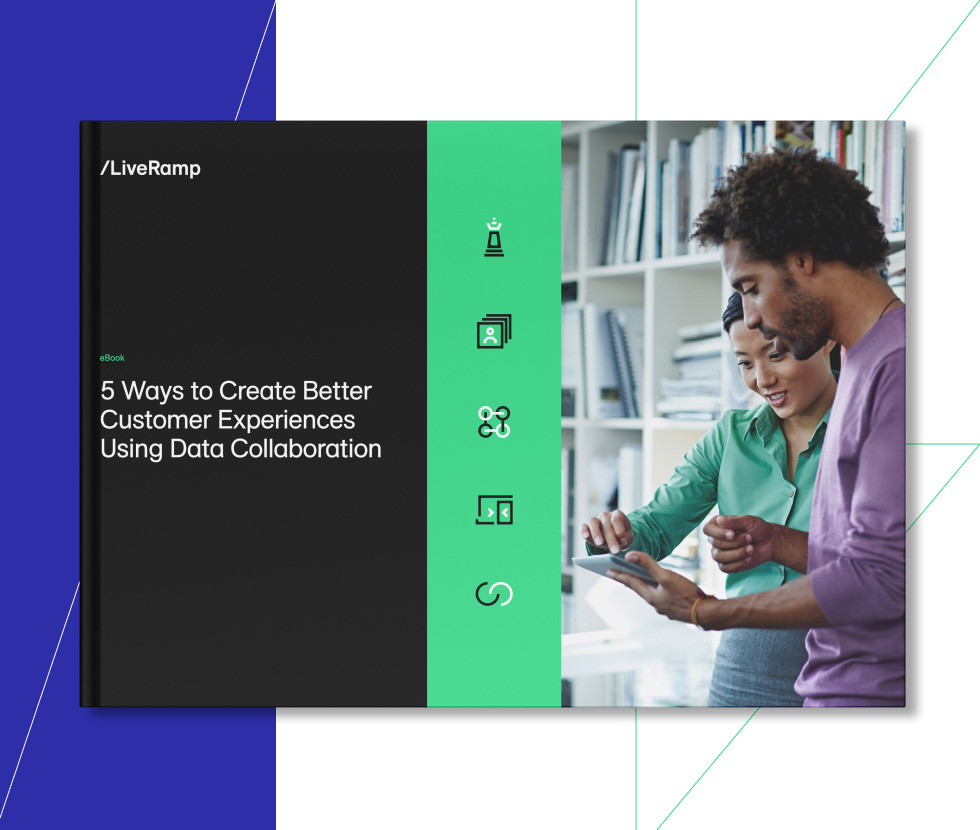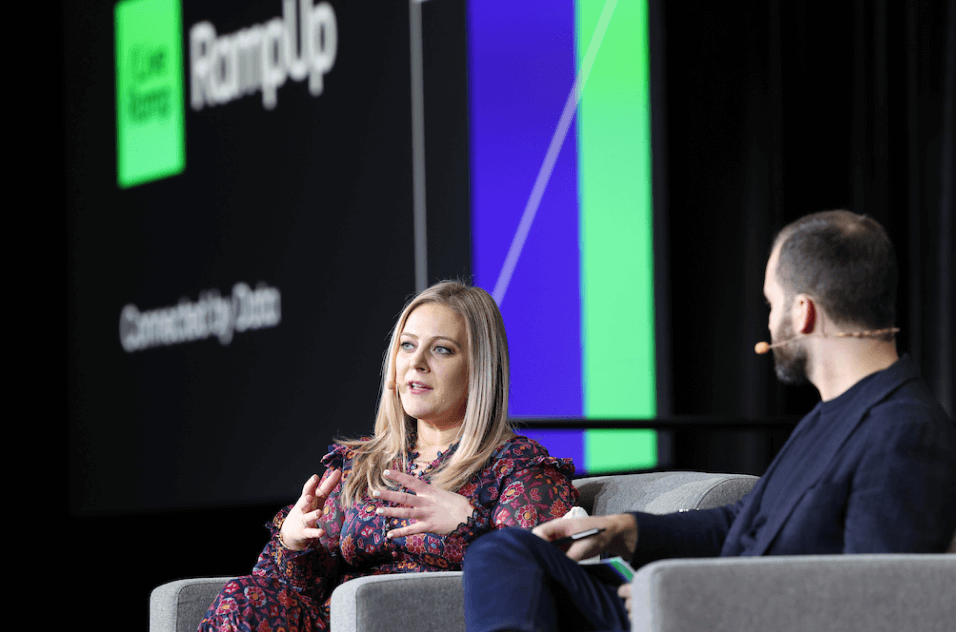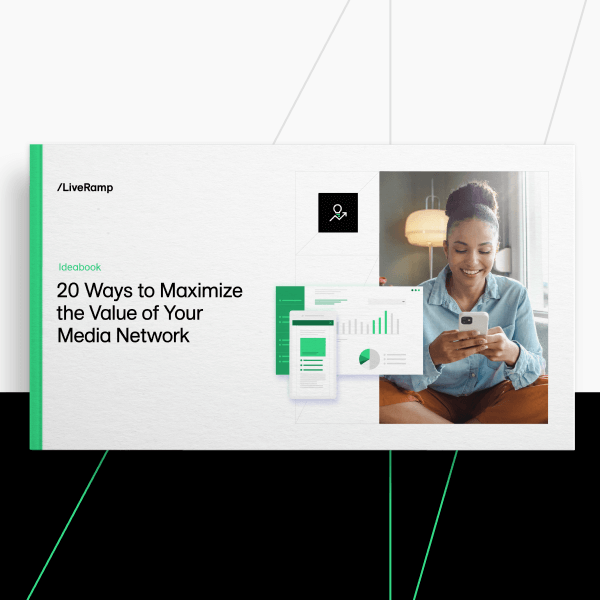What is a media network?
A media network allows brands with rich first-party data to open up new revenue streams by offering highly personalized ads and closed-loop measurement to advertising partners. For CPGs and other companies with limited first-party data, buying ad space in a media network opens up new ways to reach consumers, measure and improve performance, and unlock powerful new insights through data collaboration.
How do media networks work?
Media networks are powered by first-party data and data collaboration, allowing companies to combine data sets to illuminate previously hidden insights and create a richer, more complete customer view to fuel innovation and drive business value. To own a successful media network, a company should have a rich, large amount of first-party data.
Media networks can also act as a full-service media provider—from creative to activation of media to measurement—for partnering brands. No matter the service options, it’s essential that a media network is flexible to accommodate how, where, and when advertisers want to buy ads to reduce friction in the buying cycle and fuel business.
Media networks create an environment for companies to share valuable and unique consumer insights, so both enterprises can:
- Obtain a clearer understanding of customer buying patterns
- Create more personalized and engaging campaign content
- Deepen customer connections
- Make critical business decisions in real-time
To reap these benefits, companies that want to own a media network must build their network to support future innovation and growth. This is essential for adapting to swift industry changes, addressing privacy concerns, and meeting evolving consumer preferences. A critical step in building a flexible media network is choosing the right partners that understand the network’s mission and goals.
Learn more about the power of data collaboration. Download the eBook, 5 Ways to Create Better Customer Experiences Using Data Collaboration.
Read NowMedia networks are not just for retailers
Retailers are known for pioneering large-scale media networks, but companies across industries can take advantage of the opportunities and benefits that media networks offer. Companies in travel and hospitality, financial services, app-based services, automotive, real estate, and sports and entertainment are exploring the potential of media networks for driving innovation. What matters most when starting a media network is the amount of first-party data your company has and a plan to grow that data through collaborative partnerships.
Today, more than 80% of CPGs invest in at least one media network, and 85% of CPGs plan to increase their media network investments, reported McKinsey. But this opportunity isn’t limited to CPGs and retailers. McKinsey also found that more than 75% of non-CPG brands plan to increase spend with media networks in the next year—creating massive opportunities for media networks outside of retail to lead in innovation and revenue generation.
Tripadvisor’s media network collaborates with restaurants and hotels to target high-intent customers with stronger personalization.
Watch VideoWhat are the benefits of a media network?
A media network benefits everyone—the company that builds it, the brands and advertisers that partner with the media network, and consumers that engage with the network’s ads. Companies that monetize their first-party data and enter into innovative new collaborations create opportunities for advertisers to engage with consumers, drive sales, and access hidden insights from closed-loop measurement.
Media networks have risen in popularity as companies realize the many ways media networks fuel the flywheel for brands and businesses, including:
- Driving new revenue
- Strengthening strategic business partnerships
- Delivering more personalized customer experiences
Here are a few ways that media networks are unlocking growth for media network owners and partners.
Discover new consumer insights to drive sales
A media network allows a company with first-party data at scale (at least 5 to 10 million consumer records) to create new audience segments to monetize and share with partnering brands. The partner brand can combine the media network’s audience segments with its own first-party data to discover new insights. By combining unique data sets, media network partners can create personalized, targeted ads for consumers across websites, apps, and in-store experiences, suggesting products and services based on fresh customer insights.
Each partner should be able to easily control which data other partners have access to, how they can use that data, and for how long. By discovering customer preferences in a privacy-minded way, brands can create marketing content tailored to consumers, improve targeting, and ultimately drive more sales.
Access closed-loop measurement for accurate media spend results and campaign agility
Once an ad within the media network is launched, both companies can access exposure data for closed-loop measurement. Closed-loop measurement ties a sale directly back to the ad and audience segment, so marketers can track and report on the impact of media spend for revenue generation.
Accurate closed-loop measurement also helps marketers make quicker decisions to optimize marketing programs.
Below you’ll find specific benefits for companies that want to own or partner with a media network, as well as benefits for the consumers interacting with ads in the media network.
Tap into the hidden value of your customer insights
Unlock new revenue streams and strengthen partnerships via data monetization.
Download EbookWhat are the benefits of owning a media network?
The benefits of owning a media network are infinite, as enterprises work together to discover new innovations. Here are a few ways that businesses can benefit from owning a media network:
- Establish new, high-margin revenue streams that drive profit
- Unlock consumer trends and preferences that drive product innovation
- Deepen relationships with strategic partners for more enterprise value
- Uncover unique consumer insights that drive personalized audience targeting, fuel online and in-store traffic, and increase brand loyalty
- Provide customized and fresh product discovery for consumers
What are the benefits of partnering with a media network?
Companies that partner with media networks open a new world of consumer insights. Here are the key benefits that result from partnering with a media network:
- Discover a new, fuller view of consumer habits, preferences, and product interactions across channels for greater customization
- Reveal powerful, new insights while respecting individual consumers’ privacy choices
- Prove out the value of media investments with closed-loop measurement
- Form deeper strategic partnerships across companies and brands to unlock value and innovation
How do media networks benefit consumers?
A media network can only succeed if it benefits consumers across the customer journey with more personalized, relevant experiences and offers. Media networks help consumers:
- Discover new and highly relevant products, offers, and services
- Engage with favorite brands and new brands at a deeper level
- Enjoy more customized, personalized experiences in store, online, and across platforms
The potential for accelerated innovation is endless in a media network. This collaboration across enterprises is the key to new revenue streams, richer customer experiences, deeper partnerships, powerful product innovation, and enhanced measurement.
6 examples of media networks across industries
Brands across industries can profit from the possibilities that media networks unlock. The most powerful media networks use data collaboration to combine data sets across brands and unlock new consumer insights in a privacy-focused way.
Here are a few examples of how companies in different industries are leveraging the power of media networks:
1. Casey’s Access
With a customer base that shops in store an average of five times a week, Casey’s has the data to deliver valuable consumer insights to brand partners and advertisers with transparent closed-loop attribution. Besides driving more customer value, Casey’s media network is also generating more revenue for brand-building.
Through CVS Health’s ExtraCare program, CVS has rich shopper data that provides fresh insights to CPGs partners, along with insight from millions of daily in-store transactions. This enables brands to target customers more precisely, create strong incremental investment return, and reach consumers in a relevant, trustworthy way.
Learn how CVS Media Exchange (CMX) is evolving its retail media flywheel for long-term impact in the webinar, How CVS Built Its Retail Media Flywheel.
Dollar General’s media network, DGMN, is connecting brands to America’s rural customers for expanded reach and measurement opportunities in digitally underserved communities. DGMN is able to reach 100% of active customers through paid media and has more than 90 million unique customer profiles.
Or, as Chad Fox, SVP and Chief Marketing Officer at Dollar General, puts it, “DGMN creates natural connectivity between advertising and in-store purchases for a frictionless customer journey. With the right priorities for individual audiences, brands and consumers gain a smoother experience and a more customized path to purchase.”
Giant Eagle is leveraging its first-party data and consumer insights to digitally transform the shopper journey. Insights from the retailer’s media network have led to a new loyalty app, expanding customer experiences beyond in store and creating more benefits for both customers and partners.
Since launching its media network, Sam’s Club is creating a first-rate member experience with ads that deliver more value throughout the shopping journey. As a result, Sam’s Club MAP is fueling the business flywheel and Sam’s Club membership is at an all-time high.
During the pandemic, Tripadvisor worked with Lysol to launch the “Travel Safe” campaign, using the media network’s data to target owners of hotels and restaurants with Lysol kits for better health and safety awareness.
Here’s how Christine Maguire, GM/VP, Global Media Business at Tripadvisor, explains how their media network is generating new opportunities: “We are a two-sided marketplace with businesses and with travelers and consumers. But we also have things like sponsored placements across our restaurants, hotels, and our experiences that can target the high-intent users that are about to book. We also have transactions happening on the site, so we know exactly when somebody is booking, and then how to think about ways to retarget them for things that they would want to buy.”
Learn how DG Media Network is closing the digital gap between brands and rural communities for more meaningful customer experiences in store and online.
Read Customer StoryThe role of partnerships in a media network
Innovative partnerships drive significantly more value for media networks. Working together in an environment that respects each partner’s privacy requirements without fail is essential.
With a media network that can enable secure data collaborations while protecting consumer privacy, companies can forge partnerships that establish loyalty and trust with consumers while staying ahead of evolving tech and consumer trends.
Closed-loop measurement between partners is also a must. Companies must be able to consistently test, measure, and improve media performance across every touchpoint across marketing channels.
“The member experience is something we think about every day—whether they’re in the app, on the website, in the club, they’re using their phone—we have that transaction,” said Austin Leonard, Head Of Sales, Sam’s Club Member Access Platform (MAP).
“Because it’s a membership model, we have the ability to have a 100% closed loop. We can track back to every transaction, and it’s a big part of why the next frontier is partnering so we can talk to our members before they start that shopping experience and then retain them afterwards. It’s a big part of how we’re building that business together.”
How do media networks drive personalization and protect consumer privacy?
A core component of a media network is an enterprise identity, which ties customer data together across an organization’s various business units, functions, and data sets while respecting consumers’ privacy choices.
A consistent, unified identity framework allows companies to reconcile disparate customer information and combine internal data sets for a more complete customer view.
This is how NBCUniversal uses a unified identity to connect customer information across its enterprise.
“We’re in a market with 1,200 first-party data attributes, and then we work to be interoperable so we could make this data meaningful to our brands as well as our advertisers,” said Kaitie Coghlan, SVP, Data Product & Partnerships at NBCUniversal. “We’re interoperable with identities, clean rooms, with UIs so we could get this data into the hands of our brand marketers, our advertisers, our sponsors, our partners, so they could have meaningful engagements with our consumers.”
Learn how NBCU is powering data collaboration across brands and enterprises.
Watch NowHow can I start a media network?
If a company has rich first-party data that could be valuable to partners, advertisers and publishers, it’s in a great position to start a media network. This foundation of rich first-party data is crucial as advertisers want scale and performance when deciding where to place media budget.
To start a media network, a company might begin by monetizing its first-party data to partners looking for targeted ad options. First-party data is key for advertisers looking to access new information about existing and future customers. By combining first-party data and audience segments, media network partners can build a fresh view of customer preferences, behaviors, and needs.
The strongest media networks go a step further by collaborating with brands and publishers in data clean rooms. This happens when two or more companies combine first-party data sets to create a unique second-party data set with new customer insights that can be shared and analyzed in closed-loop measurement. Through this collaboration, the customer can be reached with more relevant, right-time offers across channels and platforms and new, innovative business insights can emerge.
Questions to ask when starting a media network
Before starting a media network, a company should consider the following questions:
- Can your audiences provide unique value to partners? Does your data fill a need for advertisers? Wakefield Research found that advertisers prefer to only work with media networks that have at least 6 million unique consumer profiles.
- Do you have permission to share consumer data through opt-in or opt-out policies? Are your policies up-to-date with current regulations?
- Do you have enough first-party data to share with partners in your media network?
- Do you have a strategy to continue to expand on the value of your data?
- Can your data be extracted for advertising purposes?
It doesn’t matter the industry or company size, if an enterprise has consumer insights that could provide an essential value to other brands and advertisers, it’s in a great position to unlock the brand-building power of a media network.
Media network trends and outlook
By delivering immense value to companies and consumers, media networks are becoming one of the largest media channels in the world, according to Forbes. Not to mention, investments in retail media networks alone have tripled in the past three years and are expected to double again. Companies that want to build or expand a media network should prepare for the following trends:
Trends in privacy
As more privacy laws are adopted across the United States, media networks may face changewinds in standardization. This could mean changes to measurement and transparency in data collaboration partnerships. In the face of these changes, it’s critical that media networks are built on a strong data foundation with partners prepared to facilitate data collaboration in a flexible and privacy-focused way.
Cookie deprecation
With cookie deprecation and increasing privacy regulations, companies need more privacy-sensitive data to fully understand consumers’ habits, behaviors, and needs. As third-party data becomes limited, first- and second-party data is even more critical to execute targeted marketing campaigns.
Media networks serve as the entry point for companies to share first- and second-party data to better serve consumers and fuel business growth.
Dive deeper into how to build a strong media network. Download the 5 Step Guide to Building a Winning Retail Media Network.
Read NowThe future of media networks
Media networks are growing incredibly fast. For example, McKinsey predicts that retail media networks could amount to $100 billion in ad spending in the U.S. by 2026—and this is only one industry.
As brands realize the potential of media networks and see a fuller view of customers, the possibilities for innovation across brands, products, and consumer engagement is endless.
So, the question is: How could your company benefit and grow from a media network?
Download our ideabook to learn how to unlock your media network’s full potential with growth and innovation.
Read Now







